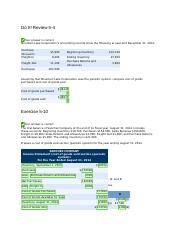Identifying Internal Risk Factors and External Risks In Project Management

For example, companies can carry credit insurance, which usually costs one-half of 1% of each dollar in sales revenue held on the accounts receivable ledger. In the world of finance, risk refers to the chance that a venture’s end result will be negative or in a loss. Some of the types of risk include operational risk, market risk, liquidity risk, and inherent risk. Inherent risk is the natural risk that occurs without any risk management controls. Companies should tailor their risk management processes to these different risk categories. A rules-based approach is effective for managing preventable risks, whereas strategy risks require a fundamentally different approach based on open and explicit risk discussions.
Run A Risk Analysis
The ultimate risk posed to the company also depends on the financial exposure created by the inherent risk if the process of accounting for the exposure fails. Strategically evaluating and managing risk is critical for fraud prevention and the overall security of your organization. balance sheet accounting tools A strong, risk-based internal audit function will help you understand major risk areas and work to reduce fraud risk.
A Roadmap for a Thriving Workplace Culture: Minimizing Risk Through Intentional and Consistent Action
We’ve developed a checklist to help you identify areas that could be susceptible to fraud. This form is protected by reCAPTCHA and the Google Privacy Policy and Terms of Service apply to the reCAPTCHA services. You can learn more about how NAVEX processes your personal data by reviewing the NAVEX privacy statement. When it comes to PESTLE, Walmart is like a retail ninja, sidestepping global politics, outsmarting economic shifts, and embracing technology – all while keeping those aisles stocked. Staff who become ill or injured and, as a result, are unable to work can decrease production.
SWOT Analysis Example For Employee
The skills, motivation, and productivity of employees directly affect business outcomes. For example, companies like Apple place heavy emphasis on retaining top talent to drive their product development. Human resources are one accounts payable of the most important internal factors in a company’s success.
- Essentially, risks are always present – determining whether risks need to be mitigated, or managed with regular oversight, requires full visibility into the risks facing your organization.
- The three types of internal risk factors are human factors, technological factors, and physical factors.
- Understanding internal risks is essential for effective risk management, as they often require specific mitigation strategies to minimize their impact on the organization.
- It’s important to identify potential external risks so your organization has processes in place to react to and mitigate damage as soon as possible.
Financial risks, such as changes in interest rates or dependence on one key customer, can impact business operations and require careful management. It can be thought of as any risk that can be identified and managed by that same organization. Internal risk can be very damaging to your company, so it’s important to understand how to identify and prepare for them. As an example, an overall economic downturn could lead to a sudden, unexpected loss of revenue. If a company sells to consumers in the U.S. and consumer confidence is low due to a recession or rising unemployment, consumer spending will suffer. A company may need to hire or replace personnel key to the company’s success.
An anonymous reporting service gives employees a safe way to report a potential incident so your organization can quickly address and work to mitigate the impacts. Once you’ve gathered this initial information, you’ll have a solid base to start formulating a more comprehensive risk management strategy. The potential for losses arising from adverse business decisions or improper implementation of decisions that affect the organization’s ability to achieve its goals.
Strikes can force a business to close for the short-term, leading to a loss in sales and revenue. Inherent risk is an error or omission in a financial statement due to a factor other than a failure of internal control. Control risk, on the other hand, refers to the misstatement of financial statements due to sloppy accounting practices. While it’s possible to have an internal audit function entirely in-house, you also have the option to outsource or cosource your internal audit. These risks may originate externally, but can have huge internal repercussions for your organization and the communities, regions and industries you work in. These risks demand urgent attention and action as they are likely to escalate quickly.
Sneak Peek: NAVEX Next, September 19, 2024 Keynote Preview

Strategy risks are those a company voluntarily assumes in order to generate superior returns from its strategy. External risks arise from events outside the company and are beyond its influence or control. Sources of these risks include natural and political disasters and major macroeconomic shifts. Risk events from any category can be fatal to a company’s strategy and even to its survival. Studying internal factors is critical for business success because it allows companies to identify strengths and weaknesses that are within their control.
They often affect teams and productivity over extended periods, risking attrition, poor morale and affected productivity if they aren’t kept under control. A healthy workplace culture where your people can have open conversations about workplace issues before they become longer-term problems will help manage these kinds of risks. The way a business is structured influences decision-making and flexibility. For example, flat organizations, such as many tech startups, foster faster decision-making and innovation, while hierarchical structures may slow processes down. Whether you’re how many days after a month ends should the bank reconciliation be done facing an internal risk or external risk, risk assessment and risk audit management software is a vital part of running a business.


